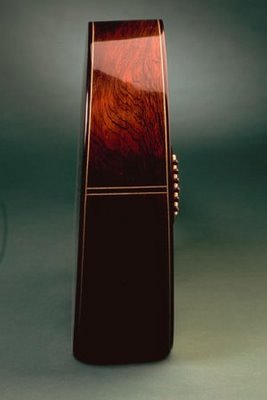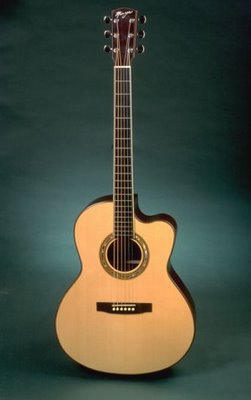Linda Manzer’s “Wedge” Acoustic Guitar

While Building The Ergonomic Guitar has focused primarily on electric guitars, many of us enjoy playing the acoustic guitar where ergonomics is no less of a concern. Fortunately, several acoustic guitar makers address ergonomics in their designs as well. Noted luthier Linda Manzer of Manzer Guitars, the originator of The Wedge©â„¢ tapered guitar body, is one such guitar builder.
Originally seen on Pat Metheny’s radical 42 string Pikasso, The Wedge©â„¢ tapered body involves building the guitar so that the bass side is narrower than the treble side – a rather revolutionary step in the acoustic guitar world. Linda “wanted Pat to be able to see the surface of the guitar in order to pluck the correct strings, but the added bonus was that it is actually a lot more comfortable to play.”
For the acoustic guitar player, The Wedge©â„¢ provides two clear benefits. First, rotating the guitar’s surface toward the guitarist reduces the potential for neck strain. Second, like an electric guitar’s forearm bevel, the thinner bass side brings the arm closer to the body alleviating strain on the shoulder joint. According to Linda, “when Bruce Cockburn developed a pinched nerve in his right arm, he traded in his much loved – but deep bodied – Blue Manzer steel string for a ‘Wedged’ Manzer model. Immediately it made a world of difference to his comfort level of playing and he was very happy and very relieved.”
With such benefits, The Wedge©â„¢ is available on the range of instruments Linda builds from steel string to nylon string to archtop. However, Linda’s work is in high demand and there is a wait. As of this writing, the waiting list was closed but expected to reopen soon.

Fortunately, Linda welcomes other luthiers to incorporate The Wedge©â„¢ in their own instruments and several guitar makers now offer it as an option. As guitar players, we have Linda Manzer to thank not only for her vision in seeing past tradition but her willingness to share her design with the guitar building community.
Looks great could i get some plans for it.
Jerry – Linda Manzer does not sell plans for her instruments and I’m not aware of anyone who makes a similar plan based around the wedge design. However, there’s no reason that someone couldn’t work out the necessary changes starting with a conventional acoustic guitar.
If you’re looking for a great reference on acoustic guitar building, you can’t go wrong with Guitarmaking: Tradition And Technology . I haven’t tackled an acoustic guitar yet but this book is incredibly detailed with excellent illustrations and photos of the process. If I should get around to building an acoustic, I would have this one by my side.
. I haven’t tackled an acoustic guitar yet but this book is incredibly detailed with excellent illustrations and photos of the process. If I should get around to building an acoustic, I would have this one by my side.
Hi Linda,
I am impressed with your wedge shape guitar. I admire any one who tries to push the bounderies and doe’s not just do things the same as most others, who generally just follow the leaders. I’m not talkinhg about the masters but rather those that lead in big brand names. If it wasn’t for people like you the future of the guitar would stagnate. I am impressed that you had the oppotunity to work with Jimmy D’aquisto. He must have been some guy. I am not a guitarist but have a small collection and am very interested in the acoustic tone and sound of the guitar. I have couple of Japanese D’aquisto’s and I like them very much. Their sound is what I would call middi but I like that sound. As a sound engineer I am confronted with performers and musicians who often want lots of bottom end an lot of high sizzle and don’t understand the value of mids or a the full balanced tonal range. With flattops which I don’t have many of, because my love is archtops, I have noticed that again, there is thing about lows and highs that often seem to take over the guitars overall balanced sound. I have found that replacing the bronze strings with Gibson vintage or L5’s rounds (Or Simlar)will give me a more balanced sound than the bronze. My D’aquisto Centura came with that kind of string and it sound just right. Anyway, what would I know? As I said I am not a guitarist but I still have to listen to lots of boomy ringing guitars which are more of a trend than a sound. I suppose they help me appreciate good old Willie Nelson as a guitarist even more. Keep up your good work.
What I would like to see on any acoustic guitar, especially classical ones to be played when sitting down, is one negletced item regarding ergonomics. That the lower side, that rests on the legs, laps, thighs should NOT be of clear lacquer finish. It ought to be satin, or even rugged. Ever had problem with – say – Ovation guitars slipping and sliding away while playing?
It occured to me while visiting a local luthier, and played an about-to-finish guitar, that was just set up to see how it performed and sounded before going into the final stuff. I noticed that the rugged surface acted as a pseudo Velcro strip on my jeans and actually made the guitar more stable when playing.
I think that since that bottom is rarely ever seen or shown, they could just oil it and make it stay rugged or unfinished, at least not with several layers of shiny lacquer, that looks good, but you could skate on it if you could…
The only drawback I could think of that you can’t play in shorts summertime, it would cause a rash on you bare legs… 🙂 And of course, when standing up, it doesn’t make any sense.
I couldn’t agree with you more, Mats. As nice as the finish might be, it’s impractical on the lower bout of the guitar.
And I completely identify with the slippage issue with the Ovation roundbacks. I happen to own one and know exactly what you mean. A rough surface where it meets your leg would be ideal and would be easy to incorporate as a surface treatment.
I am a guitarist and completely agree with Mats and Robert. Guitar slippage has been a problem for me while sitting down to play for 35 years now. And as I get older, I tend to be more comfortable, (and play better), while sitting down. I don’t know about completely doing away with a protective coat on the lower bout of a guitar, but there must be guitar finishes that don’t behave like nitrocellulose lacquer…reminded of the Paul Simon song: “Slip-sliding’ Away”.
Another point I’d like to make is that nitrocellulose lacquer on the back of the neck has always been a problem for the opposite reason. Ever had a moist, (not wet), left hand that got caught up on the back of the neck with this finish. The best, and I mean the best finish for the back of a neck, especially if it’s mahogany, is a few coats of simple Tung Oil on the bare wood. The neck is slicker and much easier and faster to move your left hand up and down the neck with a Tung Oil finish.
As for Ovations and slip-sliding away, I had a friend who owned an Ovation who glued a patch of velcro to the lower bout and sewed the other side of the velcro to his jeans, so the darned thing wouldn’t go flying off his lap. Very inventive, I thought. Cheers!
Tung ain’t exactly moisture proof But have you tried using a light spray of silicone lubricant? It doesn’t stain and is not tacky, on a nitro finish that is?
Dave, Tung Oil is very moisture proof if the initial coats on bare mahogany neck wood number at least 3 with a full day in-between coats. Plus you have to repeat the oiling process at least once a year.
As far as using any kind of silicone on instrument wood is inviting disaster. Silicone and wood DO NOT work well together at all. If you don’t believe me, contact any luthier and ask that question about silicone and wood. I guarantee that you’ll get the same response. Silicone + wood = disaster.
Yeah, it has its drawbacks. Thinking of classical, when you’re into public performance, the formal wear seems to be tuxedo, (or tails) and the pants that goes with them are of very delicate and of thin fabric. Thus, using such a guitar all of the time, would wear those trousers out fast. You CAN actually place something there, similar to the Ovation, of rugged rubber, that makes the guitar still and doesn’t wear on your bare legs or rip the trousers up. I think Linda Manzers wedged design, as well as a – sort of – funnel design, i e that the back are of smaller dimension than the top, funnels the sound out as well, are sort of helping that too. When the angle of the lower bout forces it into the leg a little bit more stiff. Because your leg, when sitting down, is not at an 90 degree straight angle, it drops slightly down to the floor. But the guitars lower bout is pretty straight (save for Linda Manzers) on the majority of guitars.
Which, of course, leads us into the older thread, and topic about removing a guitar from the body altogether, which Robert said that it has been done before, i e for classical guitarists. Some kind of heavy and heavily modified drum stand of some sort.
However where the results were I don’t know.